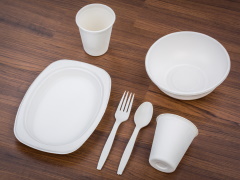Features
Putting the PLA in sustainable bioplastics
Date: 2020-05-26 11:13:40.0
Author: Jon Evans

Bioplastic dining set.
Photo: jannoon028/Shutterstock.
Even for a bioplastic, polylactic acid (PLA) is pretty sustainable and environmentally friendly. Not only is it derived from natural materials, but it is also biodegradable, which isn’t the case for all bioplastics. But there is still scope for making PLA even more sustainable and environmentally friendly, which several research groups are exploring.
For a start, the production process for PLA could be improved. At the moment, PLA is produced by feeding glucose to bacteria such as Escherichia coli under anaerobic conditions that cause them to generate lactic acid, which is then extracted and polymerized to produce PLA. But the glucose is derived from food crops, particularly corn, which opens PLA up to criticisms that its production requires the unsustainable expansion of agricultural land.
Thus, research groups are attempting to engineer microbes that can produce PLA from non-food sources such as methane and waste material such as glycerol. As well as making PLA even more sustainable, this should also make it cheaper, as methane and glycerol are less expensive than glucose, helping it to compete even better with conventional plastics.
The best option, however, would be to develop photosynthesizing microbes that can produce lactic acid, as they would merely require sunlight and carbon dioxide. Several groups have attempted to do this with cyanobacteria, or blue-green algae, but so far they have only managed to develop strains that produce lactic acid at fairly low concentrations.
Now, in a paper in ACS Synthetic Biology, a team of Japanese researchers led by Tomohisa Hasunuma at Kobe University, report developing an engineered strain of cyanobacteria that can produce lactic acid with over twice the yield (26.6g/L) of the previous best-performing strain. They did this by overexpressing the genes for malic enzyme, which causes the strain to produce high concentrations of pyruvate during photosynthesis, and lactate dehydrogenase, which converts the accumulated pyruvate to lactic acid when the strain is exposed to dark, oxygen-deprived conditions.
But it’s not just the production process that could be improved, because there is one way in which PLA is actually less sustainable than many conventional plastics, and that’s in recyclability. Whereas widely used conventional plastics such as polyethylene and polypropylene are readily recycled, PLA isn’t yet. To make matters worse, PLA is only really biodegradeable under the conditions found in a composter; it takes much longer to degrade out in the open and barely breaks down at all in water.
Now, however, a team of British chemists, led by Joseph Wood at the University of Birmingham, has developed a method for recycling PLA. As they report in a paper in Industrial & Engineering Chemistry Research, their method is based on using a zinc-based catalyst to break apart the bonds that hold PLA together, forming lactate esters. When done in the presence of tetrahydrofuran, as a solvent, and methanol at temperatures as low as 70°C, this converts the PLA into methyl lactate. Not only is methyl lactate a green solvent with many potential uses, but it can also be chemically converted back into PLA, producing a completely closed system.
In initial research last year, Wood and his colleagues showed that their method could convert virgin PLA to methyl lactate with yields approaching 100%. In this latest study, they demonstrated that the method also works on various products made from PLA, including a cup, a toy and a 3D printing material, as PLA is one of the most popular materials for a form of 3D printing known as fused filament fabrication (see Sweet smell of 3D printing). The yields were lower than for virgin PLA, due to the products containing additives such as flame retardants and plasticizers, but they were still impressive, especially as they rose with increasing temperatures. At 110°C, the yields for all the products were over 80%, reaching over 90% for the cup and the 3D material.
Wood and his team are now looking to scale up this method, which means you may soon need to find a sustainable way to sort PLA waste into your recycling bin.
The views represented here are solely those of the author and do not necessarily represent those of John Wiley and Sons, Ltd. or of the SCI.
Displaying 2 keywords used to tag this article:
- DG6582 Mens Moncler Down Jackets Gr
- Jules Audemars-Australia Best Quali
